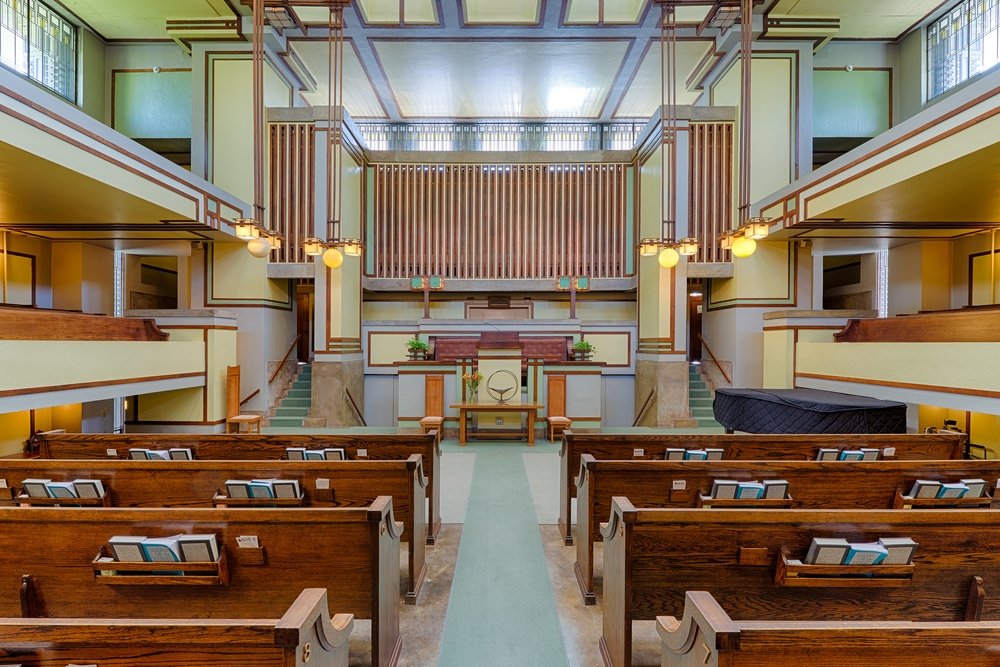© Turkuvaz Haberleşme ve Yayıncılık 2026
In the realm of 20th-century modern American architecture, few names stand as tall as Frank Lloyd Wright. Renowned as one of the greatest architects of his time, Wright brought a breath of fresh air to residential design following World War I, introducing a groundbreaking style known as the "Prairie Style."
Distinct from the European-influenced modernist techniques, Wright's designs captivated the imagination and set a new direction for American architecture.

The Prairie School movement took root in Chicago, Illinois in the 1890s, but its influence quickly spread throughout the Midwest. The question arises: Why did the U.S. require such a distinctive architectural structure? Two key factors played a significant role. First, following World War I, architects began to shift toward a more conservative approach, moving away from box-like rooms and embracing open spaces in their designs.
Secondly, a small group of architects sought to create an architectural style rooted in American identity, drawing inspiration from historical traditions and tailor-made for American soil, particularly the Midwest.
The guiding principle of the Prairie School was the extensive use of horizontal lines, combining broad eaves, craftsmanship, flat surfaces, sturdy construction, and a restrained approach to ornamentation. The movement evoked imagery of structures nestled within vast, treeless, flat landscapes, emphasizing the horizontal form.
Additionally, Wright introduced the concept of "organic architecture," advocating for structures to harmonize seamlessly with their surroundings, akin to a natural growth process.
Wright's organic approach challenged the conventional notions of architecture, forging a path for a new wave of design philosophies. The Prairie School's emphasis on horizontal lines, integration with the environment, and a departure from ornamentation established a distinctively American architectural style that resonated with both the Midwestern landscape and the evolving modernist movement.
This architectural movement took its ontological philosophy from American Transcendentalism, which regarded nature as a manifestation of the divine and that immersing oneself in the natural world could lead to spiritual enlightenment. They saw nature as a source of inspiration, a teacher and a means of transcending the limitations of everyday life.
Organic unity, in the context of Transcendentalism, refers to the belief in the interconnectedness and inherent harmony of all aspects of existence. Transcendentalists saw the universe, nature and humanity as interconnected and believed that they were all part of a greater whole. This concept of organic unity reflected their understanding of the divine presence in everything.
It appears that there is an overlap between the concept of "organic unity," which connects God, humanity and nature harmoniously. However, this similarity is not merely coincidental; it is widely known that the Prairie School of Architecture was influenced by both Transcendentalism and Romanticism. These philosophical movements held the belief that the quality of people's lives would improve in proportion to the quality of their surroundings, suggesting that a well-designed house would lead to a better society.
Robie House, which is also considered a national landmark, stands as one of Wright's most iconic and influential works. Wright's vision for the house extended beyond its exterior, encompassing meticulous designs for the interior, furniture and even rugs.
The captivating features of Robie House's exterior immediately catch the eye, with its prominent horizontal lines and a distinctively low-pitched roof. This design choice creates a harmonious integration of the house with its surroundings.
One of the notable aspects of Robie House is Wright's masterful combination of wood and brick, which adds depth and texture to the structure. The juxtaposition of these materials not only highlights the craftsmanship but also enhances the visual appeal of the house. It exemplifies Wright's belief in using natural materials to harmonize with the environment.
Moving inside, the interior of Robie House is adorned with Wright's signature art glass windows. These exquisite windows, characterized by their intricate geometric patterns and vibrant colors, serve as a hallmark of Wright's design aesthetic. They filter natural light, creating a mesmerizing interplay of light and shadow within the living spaces.

Another captivating feature of the house is the prairie-style dining room. Here, Wright employed a series of window bands, strategically positioned to maximize the inflow of natural light. This deliberate design choice not only creates a bright and airy atmosphere but also establishes a seamless connection between the indoor and outdoor spaces.
Situated in New York City, the Solomon R. Guggenheim Museum is an architectural marvel. Its spiral design, with a continuous ramp leading visitors through the museum's collections, revolutionized museum architecture and created a unique and immersive viewing experience.
The architectural structure is a captivating tribute to the beauty of geometric shapes, seamlessly blending arcs, circles, ovals, triangles and squares. However, it is the prominent circularity that truly defines the essence of this magnificent building. From its graceful curves to its perfectly symmetrical forms, every aspect pays homage to the allure of circles.
Unity Temple is widely regarded as a groundbreaking contribution to modern architecture. Unlike traditional American or European churches, Unity Temple stands out for its distinctive design. The utilization of geometric cubes sets it apart, creating a unique visual identity. The interior, following the principles of the prairie style, boasts a remarkable integration of horizontal lines that can be observed throughout the entire space.
This departure from conventional architectural norms is a testament to the innovative thinking behind Unity Temple. By embracing geometric forms and incorporating them into the design, the architect challenged traditional notions of what a church should look like. The resulting structure not only defies expectations but also establishes a harmonious blend of form and function.
Located in Pennsylvania, Fallingwater is also considered one of Wright's masterpieces. It is a house built over a waterfall, seamlessly integrating with the surrounding natural landscape and incorporating the flowing water into the design.
Taliesin, located in Wisconsin, served as Wright's personal residence and studio. It went through several iterations and expansions over the years. The structure exemplifies Wright's organic architecture principles, blending with the surrounding landscape and incorporating natural elements.
Finally, Johnson Wax Headquarters, the commercial building, located in Wisconsin, showcases Wright's approach to integrating architecture and nature. The structure features mushroom-like columns and a dendriform (tree-like) column in the Great Workroom, creating an organic and light-filled workspace.
